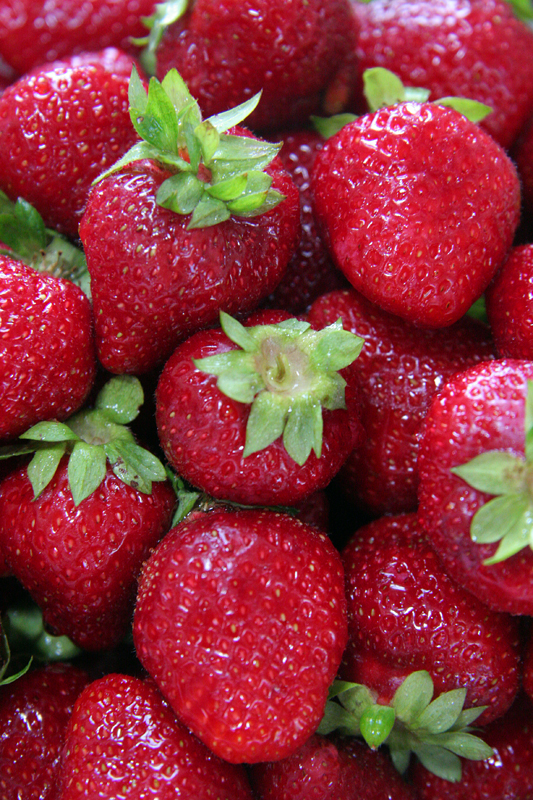December 31st, 2013 §
I was driving home last night around 9:40 after a late yoga class and grocery shopping. I was almost to the village of Free Union when I saw a white beast in my headlights, in the middle of the road. At first I thought it was a coyote, and then a wolf! But as I slowed down I saw it was a dog, a little tan and white Border Collie, so scared that it was running completely hunched into a comma shape with its tail way between its legs.
I ditched the car in the nearest driveway, which happened to be a church, and opened the door. I called to the dog, but it kept skittering down the road. I saw a collar on its neck. I called it again, using all of Patricia McConnell’s tricks to get a dog to come, bending low, making myself smaller and turning my body away so as to be less threatening, and softly clapping. The dog stopped running and turned to look at me kneeling in the middle of Free Union Road. It let me approach, and both of us had a moment of faith as I reached a hand out for it to smell, it wondering if I was a friend and me wondering if I was going to get bitten.
The dog didn’t bite me, and it let me gently take hold of its collar. In my flashlight’s beam I found a tag and learned her name was Lola. Once I spoke her name her posture instantly changed, and she let me lead her over to my car where, when I opened the door, she quickly jumped in the back seat without any extra encouragement. I was glad to see she appeared uninjured.
With Lola safe in the car I called the number on her tag. A woman answered, and she was actually speechless when I introduced myself and told her I had her dog in my car. When she regained her faculties, the woman explained that she lived in Charlottesville but was actually traveling in South Carolina. She had left Lola with her mother, who lived on the road right behind my house. The woman was so flustered that I told her I would take Lola up the road with me and call her mother to come pick her up. She agreed, and we got back on the road, Lola sitting so prettily on the back seat, looking out the window. In the dark I could hear her licking her lips, so I knew she was still nervous. But she was totally polite as we wound up the road, a sweet, beautiful, obviously smart dog that reminded me a lot of my own Tucker in her energy and spirit.
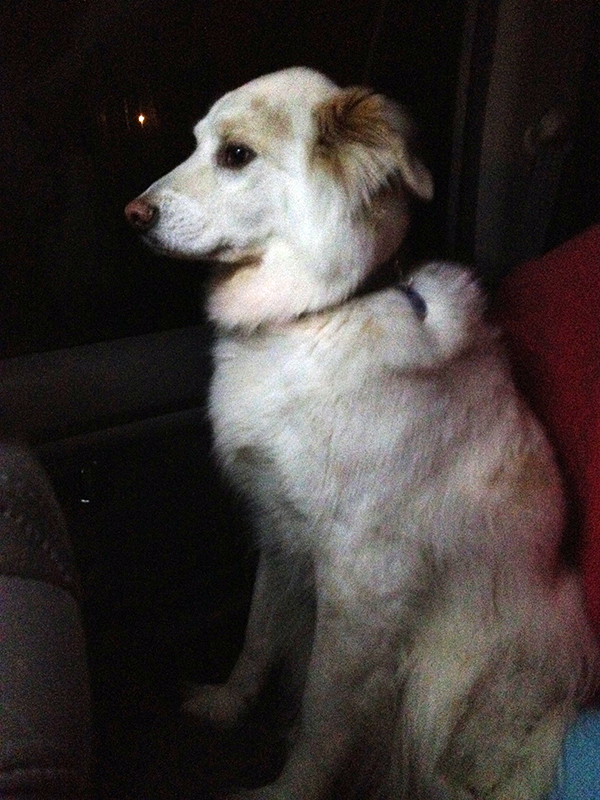
Once home I left Lola in the car for safekeeping while I got her petsitter on the phone. Within a few minutes a nice man arrived in a pickup to claim Lola. Apparently she had bolted several hours earlier, and her caretakers had been frantic looking for her before having to call their daughter to explain they’d lost her dog.
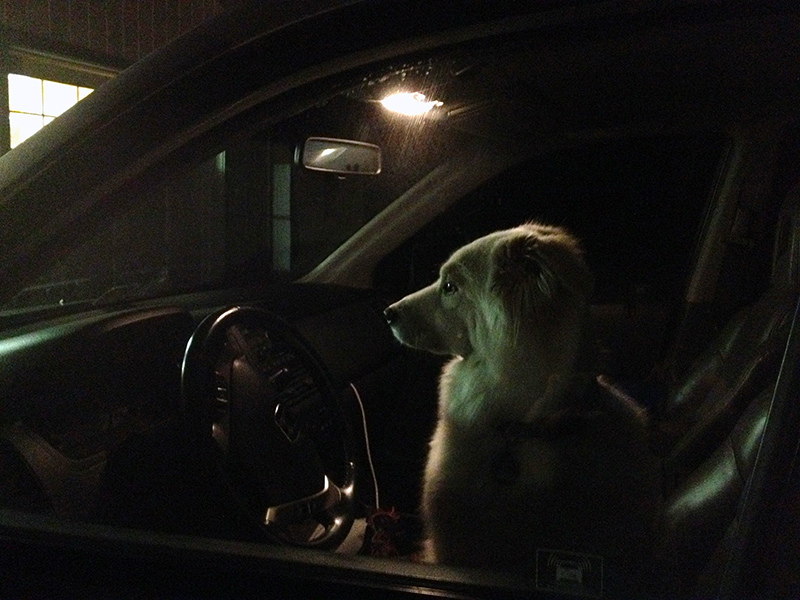
They think she was trying to get home, back to town. The man who picked her up explained that Lola was a pampered city dog, and he feared that between cars and coyotes she wouldn’t have made it long on her own. But it made me wonder—Lola had navigated five miles down three different pitch-black roads and was nine miles from home—on the right road, headed the right way—before I picked her up. It makes the movie Homeward Bound sound not entirely unreasonable.
It was after 10:00 p.m. when Lola’s owner called back to thank me again, telling me she was still so shocked. She said Lola was “like her baby” and she would have been devastated had something happened to her. I told her not to worry, that everything is okay, and to have a Happy New Year.
And with this, my dear readers, the last story of 2013, I wish you all a Happy New Year. May we all be lucky enough that adventure, heartbreak, and salvation rejoin us on the other side of midnight.
June 21st, 2013 §
It’s the longest, lightest day of the year, and a lovely one at that. I spent the afternoon processing strawberries picked yesterday in Nelson County.

Summer fruits are the best, but you know what’s even better? Strawberry shortcake, baking in the oven right now. And the chickens definitely enjoyed the strawberry trimmings!
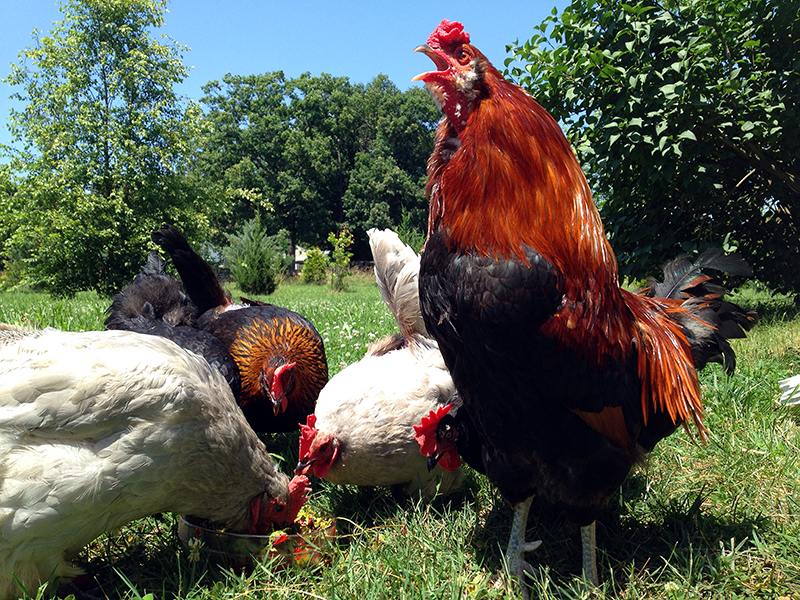
I’ve got a couple of growlers of Devil’s Backbone in the fridge and new friends on the way with fried chicken. We’re doing this Solstice up right with a good old-fashioned porch party on this beautiful evening.
Whatever you’re up to today, I hope you get a chance to celebrate the Solstice. And lest the sun hog all the astronomical attention, don’t forget to check out this weekend’s Supermoon!
June 19th, 2013 §
I just want to take a second to welcome any new readers coming over from this post on DIYdiva. Kit wrote of Bonafide Farm as a “kindred farm,” which makes my heart happy as I feel the same way about Liberty House. Squee!!
And if you’re not yet familiar with DIYdiva, check it out pronto and see if you can keep yourself from being inspired. Kit’s a beast, a “power-tool wielding bad-ass,” and another awesome chick who’s living the farm dream on her terms alone. And best, she’s snort-out-loud funny as she describes her triumphs and travails. DIYdiva is a daily read, for sure!
June 1st, 2013 §
In late March I stayed with my friend Todd in Arlington, Va. Todd is a former neighbor, and I first spoke to him as I walked past his rented house on Barton Street toward the Metro. Todd was sitting outside on the front porch, reading the paper. I complimented him on the beautiful irises growing rampant in his front yard, which is how I earned his nickname of “Iris” before he knew my real name.
A while later Todd and I got to know each other more and became friends. He’s even made the trek down to visit me at Bonafide Farm. I very much appreciate his humor and intellectual curiosity as well as his willingness to pitch in with nonglamorous labor such as driving me to the airport and and helping me move. Which involved Todd carrying about a hundred heavy book boxes, one on each shoulder, two at a time out of my third-floor apartment—a sight and a kindness I won’t forget!
Well, this latest visit was no exception, as we dug an entire bed of irises and daffodils out of his back yard. These are old beds that were planted sometime before Todd moved into the property by someone who obviously loved gardening. It was hard to tell how old the beds were, but the irises had completely filled them with exposed rhizomes growing up and over the brick edges. Definitely good candidates for division!
Though Todd has been living in Barton Manor for many, many years, one day he will have to move out and the property will succumb to the new development that’s overtaking the Clarendon area. Todd wants to make sure every last useful piece of the house and yard, living and not, is salvaged before the demolition begins. Which is how I came home with this:
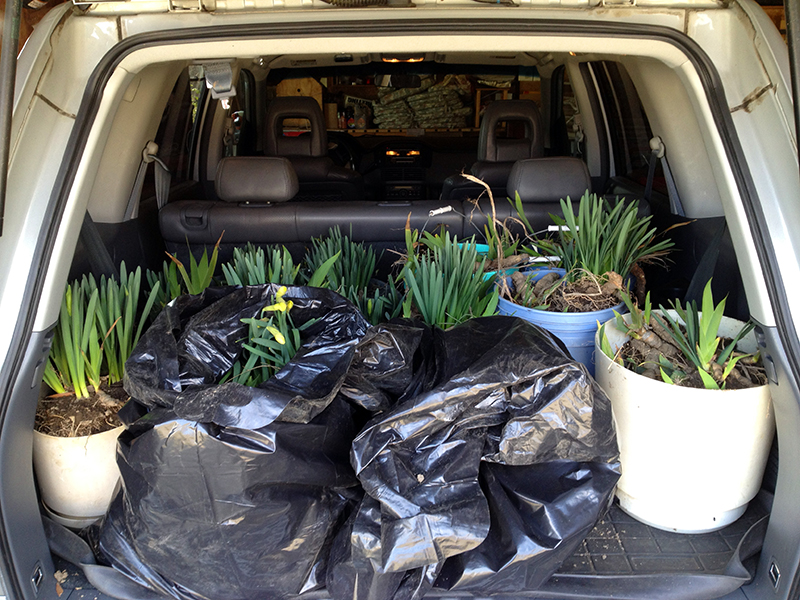
Those contractors’ bags were full of soil and plants. They were so heavy I had to call in reinforcements just to get them out of the truck. Thank goodness for the tractor!
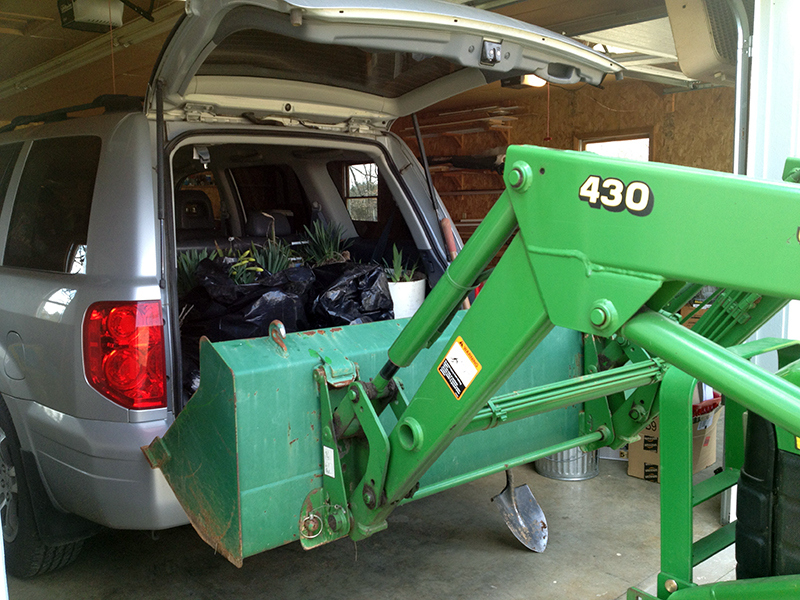
It took me an entire day to get these irises and daffodils planted in the beds around the house, below. By the end I was running out of spaces to put them, so I stuck a few clumps of daffodils around the giant oak tree at the wood line.

To my surprise the daffodils, which were in bud when we dug them, went ahead and bloomed as though their relocation had never happened. I was very thrilled to see that some of them are a fascinating type that bloom with a yellow corona (the center cup part) that then fades to a peachy pink as the blossom ages. Very cool!
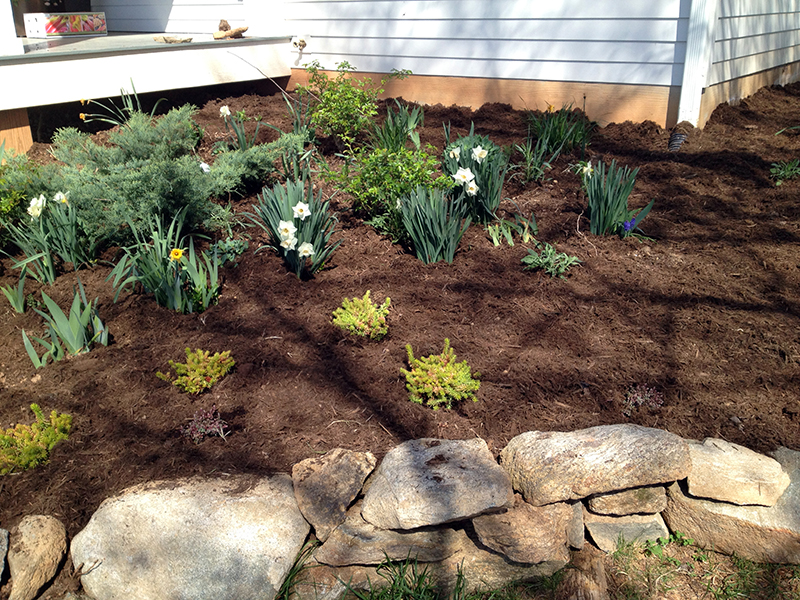
I totally didn’t expect it, given the late transplanting, but several of the irises also bloomed as though nothing had happened. I guess they like their new home.

I am very grateful to Todd for his gift and glad to see a bit of Barton Manor live on at Bonafide Farm. Seeing these plants remind me not only of my years spent living in the city but also of my good friend.
May 28th, 2013 §
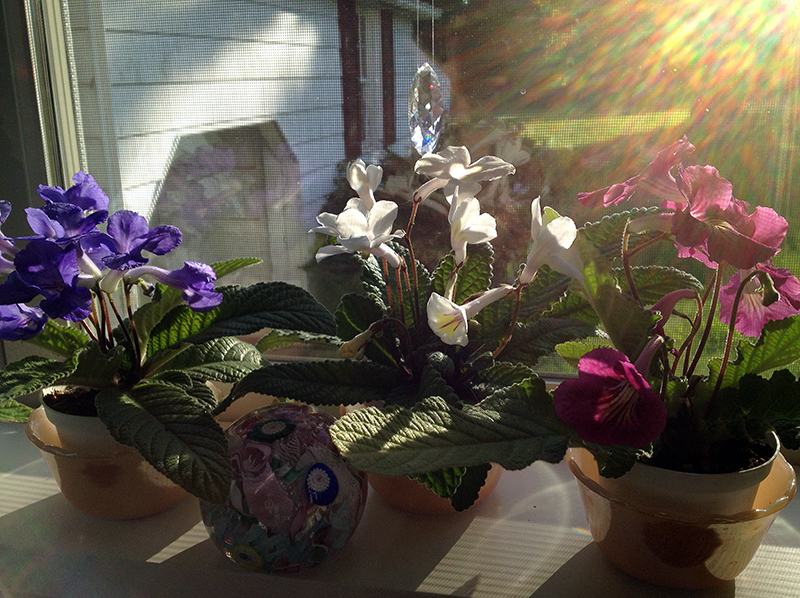
What a busy Memorial Day Weekend!
On Saturday I visited a friend for a look inside his new beehive. We’d taken an into to beekeeping class together this spring, and he won the class drawing for a complete hive with bees. After taking the class I decided against adding bees to the farm this spring, figuring that the roughly $600 outlay to get started with two hives was too much at this time. Further, there are so many things that can go wrong with a bee colony, from diseases to pests to the vagaries of weather and wildlife, that I got nervous I would screw it up and didn’t want to add that stress right now.
However, after seeing Aaron’s beehive, I am totally smitten and kicking myself that, as usual, I over thought it and didn’t jump right in. With complete sincerity I have to say that opening that hive and seeing thousands of beautiful creatures busy creating their perfect home was one of the most miraculous things I have ever seen. The precision of each cell of honeycomb blows my mind, as does the order the bees demonstrate as they go about separating comb into areas to raise brood and store honey.
We added a super (outside box), fed the bees, and inspected each frame of the hive. I learned how to hold a bee-covered frame without dropping it or crushing any bees. We found the queen, distinguished by a red dot of paint on her back, busy in the lowest super. Through this whole experience the bees buzzed about around me and I didn’t feel scared once. I was wearing overalls, my wellies, and a borrowed bee jacket and veil, along with rubber kitchen gloves. I think this delicate armor helped to alleviate any fear of being stung, but I also felt entirely calm around the bees. An inner voice told me that calmer I was, the calmer the bees would be (which is a mindfulness technique I have learned from working with all sorts of animals), and it seemed to work. I just focused on assisting Aaron and my mind was entirely present. It was strangely meditative, actually, moving slowly and deliberately so as not to kill the bees or panic them.
If anything, I’d get a beehive just to feel that peacefulness again. But I have been doing this farm thing long enough to know that the flip side of that wonderful feeling is the sadness that comes when living things in my care get sick, or injured, or fail to thrive.
I spent Sunday working in the garden, planting out a bunch of plants that Aaron sent home with me. I also fabricated more than twenty dahlia supports from 42″ tomato cages. I cut the legs off each cage, bent those wires into u-pins, and brought them to the garden, where I secured them, upside-down for stability, over the more than twenty dahlias that I planted out. I had started these dahlias in pots, some as early as March and others in April, hoping to get earlier blooms than usual. We’ll see if it works. Regardless, I will have very neatly supported plants!
I’ve also been busy tucking zinnia seeds around the house garden, and minding the blossoming veg garden. Lots going on—the growing season is upon us and I can be outside from morning until sunset and not run out of things that need tending.
Then on Memorial Day I went to a cookout hosted by new master gardener friends. When I got home, around 8:30 p.m., I bottled the beer that I made when my friends Brad (my homebrew mentor) and Amy visited in early May.
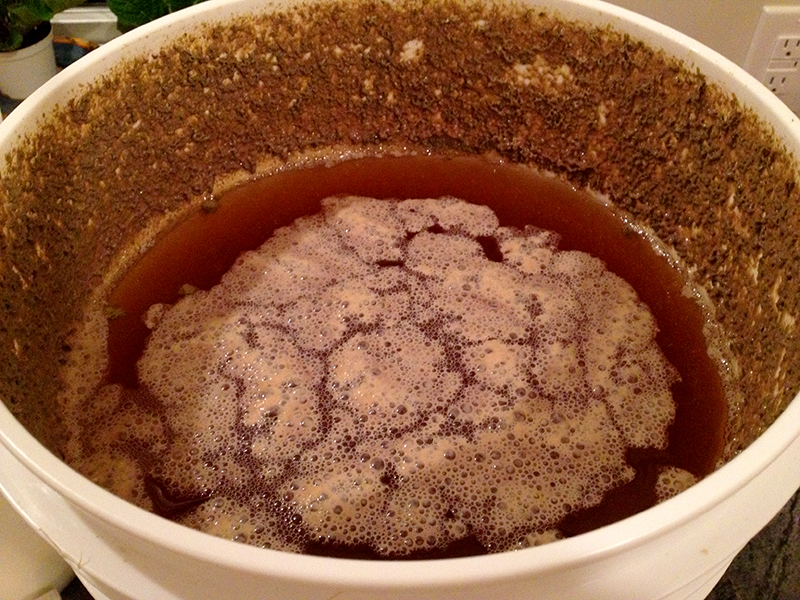
It’s a kölsch, a nice summer sipper, and I am pretty excited about it. I was nervous as the top blew off the fermenter its first day out, but that didn’t seem to negatively affect the beer.
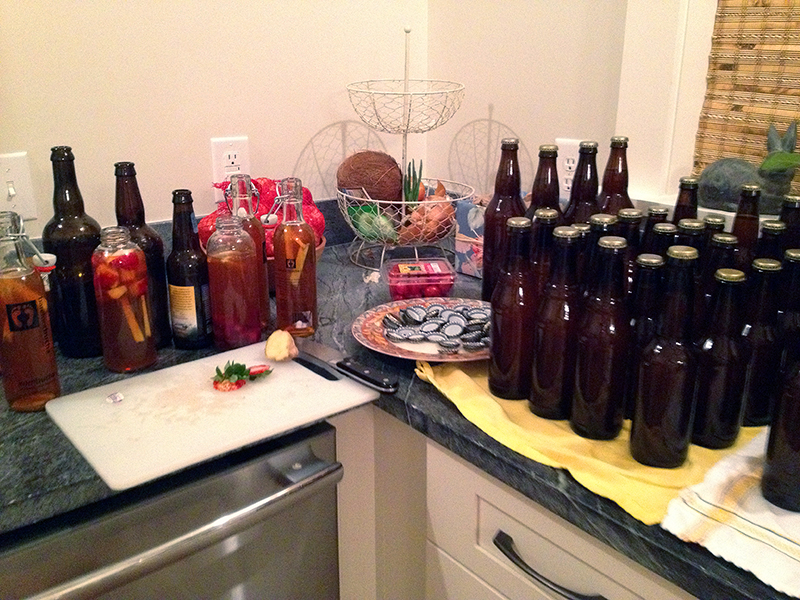
As the kitchen was already a mess, I went ahead and bottled up some of my kombucha. This is the first batch I have made in four years, and it’s delicious. I spiked a few bottles with ginger, cherries and strawberries for a secondary fermentation. And then at nearly midnight I started soaking some wheatgrass seeds, which is a new experiment. I plan to grow them out to add to my green juices.
And so things continue on: growing or not growing, fermenting, decomposing or dying. It’s all happening here, all around me.
September 27th, 2012 §
I didn’t think many people would want to start their day watching eight live chickens be “harvested” and processed, but the conference room for the 10:00 a.m. “Pluck A Lotta Chickens” live demonstration was standing room only way before the presentation began. There must have been 500 or more people there to learn how to slaughter and butcher chickens.
David Schafer, the very easy-on-the-eyes creator of the Featherman line of poultry processing equipment, and Joel Salatin, our previously mentioned hero of the grass farming movement, stood at the front of the room and introduced us to the morning’s teachers: four Cornish crosses and four Freedom Rangers that had been lovingly reared by a nearby farmer, in the green shirt below, and his family. The birds were big and glossy and gorgeous, a far cry from the half-dead creatures I saw yesterday on the road.
After David and Joel took a moment to acknowledge the birds for their lives and their caretaker for his work raising them, David placed the birds one-by-one, head down, in a wheel of metal cones. He gently extended their heads and carefully sliced the artery right under their jawbones. The blood dropped out of the birds in a gush as they calmly blinked a few times, losing blood pressure.
In a minute or so rigor mortis set in and the birds, which were no longer conscious, flapped wildly in their cones. David let the birds continue to bleed out for a few minutes more before putting them in a rotating scalder.
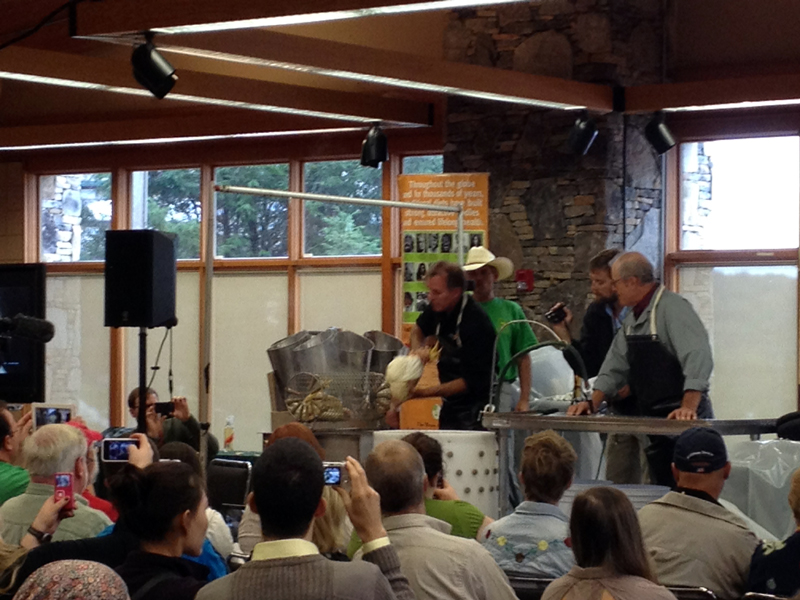
From there he put the birds in a feather plucking machine that bobbled them around until their feathers were rubbed off by rubber fingers. Then Joel took over with the butchering.
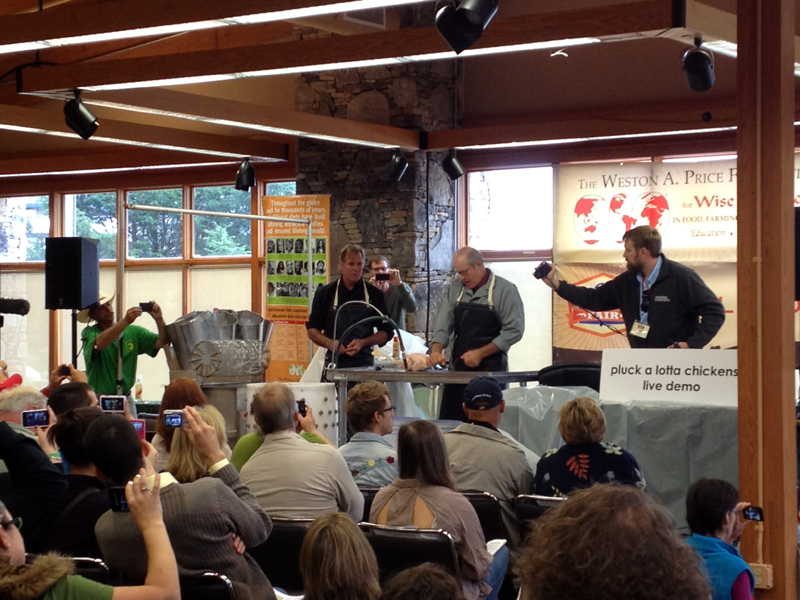
First, he pulled the head off the bird, above, a movement that surprised me by its ease. It was a bit shocking to me how easily the head came away from the body, especially after having worked so hard to keep a head attached to one of my own birds. Then Joel cut off the feet and the oil gland above the tail.
He then made a small incision in the front of the bird to access the windpipe and crop, which he loosened by scooping his fingers under it—taking a moment to remind us to fast our birds for a day before slaughter to make this process cleaner. Then he made another incision at the back of the bird around the vent and was able to pull all the viscera out with one hand. A quick tuck of the legs into a slit in the chicken’s skin and it was ready for an ice-water bath. Joel told us that when racing, he could process a chicken in 20 seconds. Wow.
The best part of the demo was how easy it looked. I’d always been a bit intimidated at the thought of butchering a chicken, anticipating a horrible bloody mess and suffering creature, but after watching these teachers—who are the most famous in the business—I think I could do it. Who knows, maybe next year will find me raising a bunch of Freedom Rangers for my freezer!
After this session I wandered over to Christy Hemenway’s talk about keeping bees in top bar hives, which look like a child’s coffin on legs. Christy runs Gold Star Honeybees in Maine and wrote “The Thinking Beekeeper.” I’ve been dancing around the idea of keeping bees for a couple of years, and have even joined the Central Virginia Beekeeping Association. But after a few meetings and a workshop I started to think that the odds are stacked against the beekeeper. Between big predators, such as bears, and tiny marauders, such as the varoa mite, I had grown disheartened even before setting up a hive and decided beekeeping was a fool’s game.
Top bar beekeeping, though, just might change my mind. In a top bar hive, bees build their own wax combs suspended from narrow wooden bars instead of colonizing premade wax foundations, which are often made from beeswax that’s been treated with pesticides to kill varoa mites. Not exactly something you’d want to eat. And when bees build their own combs, they actually build cells of a size that can’t accommodate the varoa mite. It’s a bit more of a production to extract honey from combs built in top bar hives, but the health of the bees in such a system would more than make up for the inconvenience.
After the bee talk I got some lunch. Strangely enough I went for the chicken kabobs…and noticed while in line that my choice of outfit was well-aligned with other festival goers.
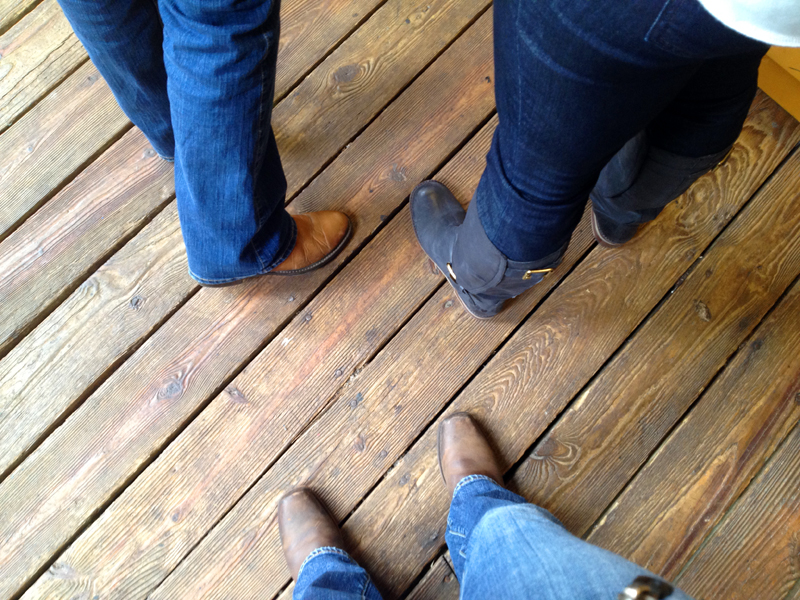
Then on to hear Patricia Foreman talk about gardening with chickens. I’d seen Patricia speak the weekend before at the Heritage Harvest Festival, and her talk was pretty similar to what I’d heard there. She advocates putting our chickens to work creating compost. As the cost of feed is increasing, and my flock size grew this summer, I was all ears. The idea I took away from this talk was that I’d like to turn my chickens out into my garden once everything freezes. I hope that they will till up the dirt and in addition to fertilizing eat all the insect eggs that are plaguing my gardening life. I’d also like to figure out how to build a chicken tractor that can detach from my coop and be moved around the yard, instead of building a permanent run.
Next up was a talk by Jenna Woginrich, of Cold Antler Farm, about how she makes her living blogging and writing. Jenna is an enthusiastic and natural speaker who kept her audience laughing. As I suspected I would be, I was even more inspired by her in person than I’ve been from years of reading her blog. Jenna boiled her success down to a combination of flexibility and stubbornness—necessary traits, she claims, for the self-employed. I admire Jenna for bucking convention and being one to say no thanks to a society that trains us to, “be scared to do what we want to do.” And we don’t need to have all the answers before we start something new—the important thing is to just begin. As she says, “You can drive to L.A. in the dark. Your headlights will get you there 200 feet at a time.”
I stuck around in the same meeting room for the next talk by Wisconsin farmer Ann Larkin Hansen. I’d heard her speak for a few minutes the day before on woodlot management, but her next presentation was on making hay. I wanted to figure out when was the best time to cut hay for optimum nutritional content, and Ann told us the legumes are the key to when to cut. You should make hay when the legumes have grown as tall as they are going to get and are starting to bud and the grasses are just starting to develop their heads. As crops grow taller, beyond this point, the quantity of your hay increases but its nutritional quality decreases. Leave 2-3″ of stubble in the field when you cut to help prop the hay off the ground, which makes it dry faster. Dry hay is key. Wet hay, if baled, can compost and selfcombust and burn down your barn. Not cool. Ann then got into haying machinery and I slipped out to meet Jenna at her booksigning.
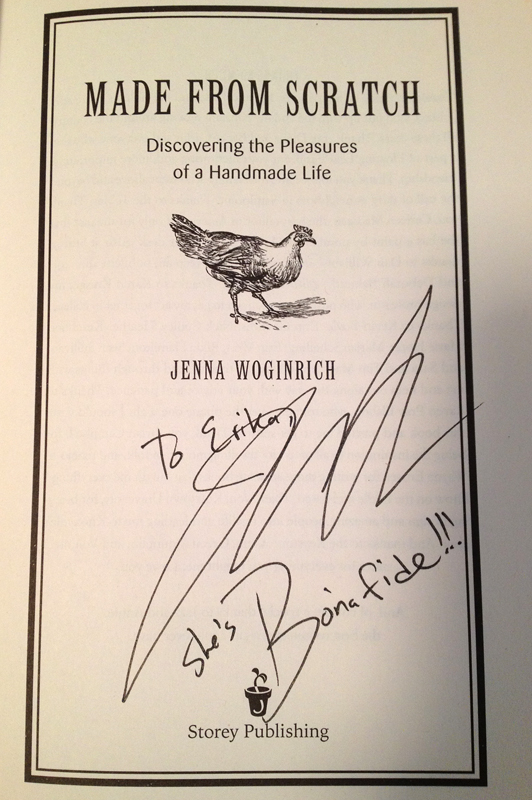
As hoped, I got to talk with her for a few minutes and tell her a bit about my farm. I bought all her books and she signed them for me before she had to run out to give her keynote, which highlighted the importance of community to any farming endeavor. Certainly true, especially for single farmers such as Jenna and myself!

And then day two of the fair came to a close and I retired to dinner and a wonderful hotel sleep. I always sleep well in hotels—I think the secret lies in blackout curtains!
Stay tuned for day three, in which we learn about heritage goats and “make friends with our kombucha!”
September 26th, 2012 §
I left Virginia for the fair last Friday around 8:00 a.m. I had planned my route to Western PA on secondary roads to better enjoy the scenery, and they didn’t disappoint as they wound along rivers and over ridges covered with reddening trees.
I had driven through a snow of chicken feathers for several miles near Broadway, VA, when I overtook a truck on its way to a chicken processing plant.

As I passed the truck I could see that the condition of these birds was appalling: they couldn’t stand and were battered and dirty and missing huge patches of feathers over raw skin. And, sadly, this glimpse I got of them is only the last chapter in lives that we all know aren’t pretty. Seeing those birds made me even more firm in my conviction to not eat commercially produced poultry and to support the farmers who are raising birds in the ways that I would no doubt learn about at the fair.

I cruised up West Virginia valleys and over several mountain ranges before stopping for lunch at Warner’s German Restaurant outside of Cumberland, Maryland. A delicious brat and a mug of beer topped me up to continue on to Seven Springs.
I relied only on my iPhone’s mapping system—Google maps, not the much-maligned IOS6 Apple Maps—and it got me there with only one small operator error. But I was back on track in less than two minutes and along my detour stumbled upon the historic Burkholder covered bridge. In true road trip fashion, best to not plan too much and just roll with it—or through it!
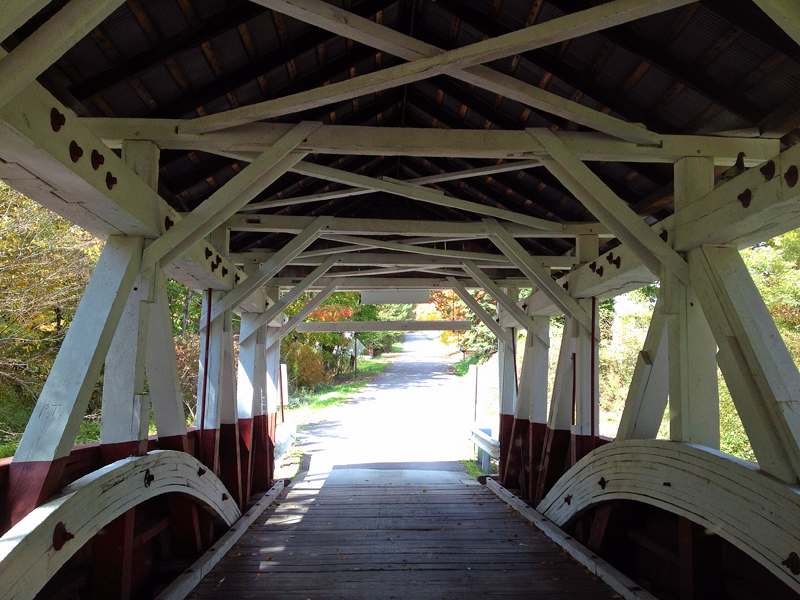
I arrived around two, checked in to my room at the resort, and immediately hit the fair. I listened to the esteemed herbalist Rosemary Gladstar, whose book is my bedtime reading at home, talk about some of her favorite herbs. I was riveted by her. She is a beautiful woman with a shining spirit. If that’s what a lifetime of practicing herbalism gets you, I’ll chew up any number of the weeds growing in my yard and smear them on my face! Rosemary described making a tea and adding a certain flower—calendula, perhaps—to the mix. She said, “I put the gold in there because medicine should be beautiful.” What a wonderful concept, that healing happens with the eyes and that beauty can make and keep us healthy. Certainly that resonates with me and how I live my own life.
After Rosemary’s talk, I headed outside to the vendor tents. One large tent held all sorts of beautiful animals: chickens, geese, cows, pigs, goats, sheep, alpacas and llamas. The intelligent eyes of this llamas really struck me, and his haughty look was a bit unnerving.
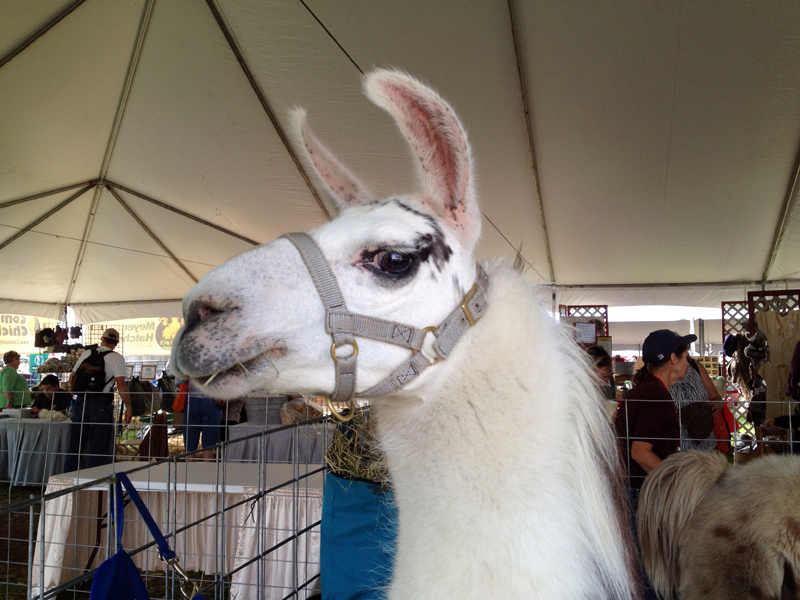
I was most enamored of the Underhill Farm booth and their display of skeins of wool from their Leicester Longwool sheep. The owner of the sheep was giving a spinning demonstration and she made the action look both easy and supremely relaxing.
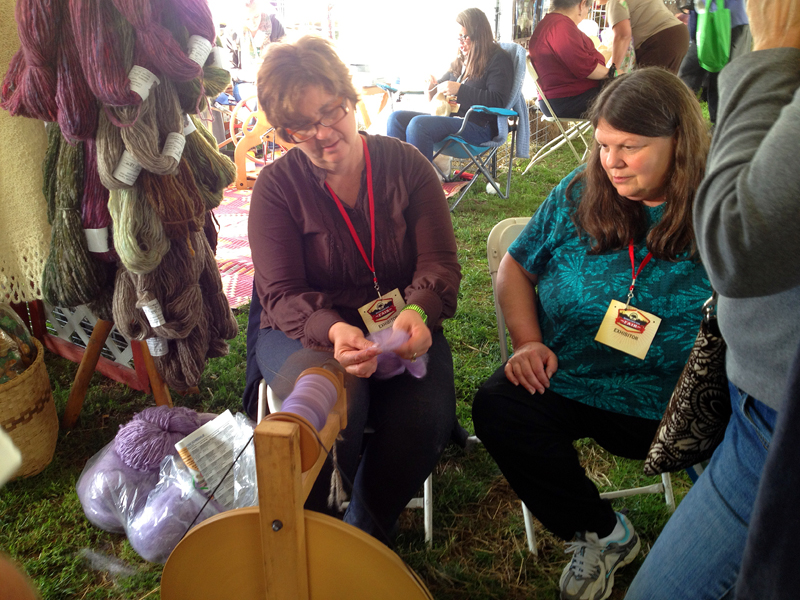
I don’t knit or crochet or know anyone who does, so I had to pass on the gorgeous skeins though they were beautiful enough to display massed in a basket or bowl.
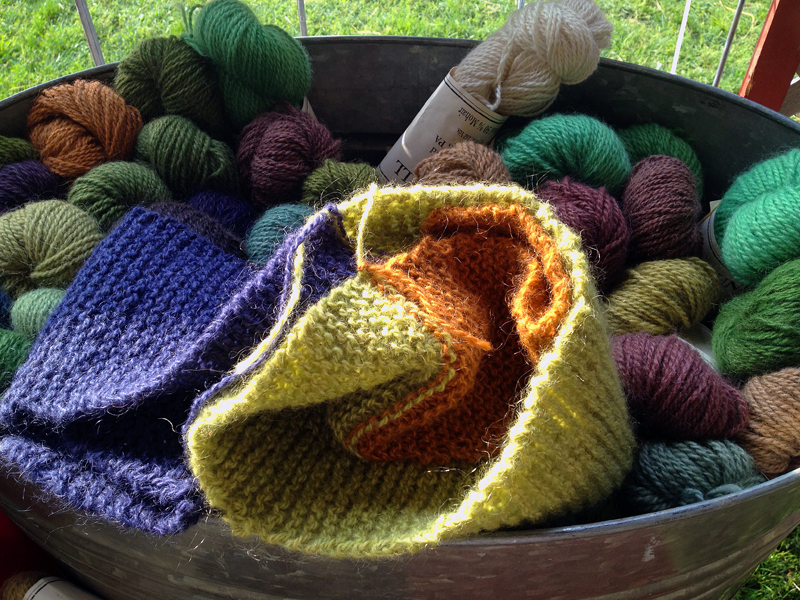
I caught the tail end of Joel Salatin’s keynote about how biological-based systems can produce enough food to feed the world, and he was as charismatic and engaging as the myths make him out to be. Given the audience, I wasn’t surprised to hear almost-evangelically supportive hoots and hollers from the crowd in response to Joel’s statements, but it was curious and wonderful to hear such rock-concert behavior at a talk about the future of our food supply.
Next I headed to a talk on small-scale sustainable farming by David Kline, an Amish farmer.

What stuck out at me was a point David made about the importance of rest as a farmer, which may seem like a foreign concept to many devoted to a lifestyle that requires constant vigilance and recalibration. David’s family slows the grueling pace of farm life on Saturday afternoons, just like his parents and grandparents did, in preparation for the Sabbath. And, he says, one of the built-in checks that forces a healthy stopping point at the end of the day is that, “horses don’t have headlights.”
Then the talks were done for the day and I headed off the resort to find dinner. I stumbled upon the best pumpkin stand I’ve ever seen with a huge variety of beautiful squashes and gourds.
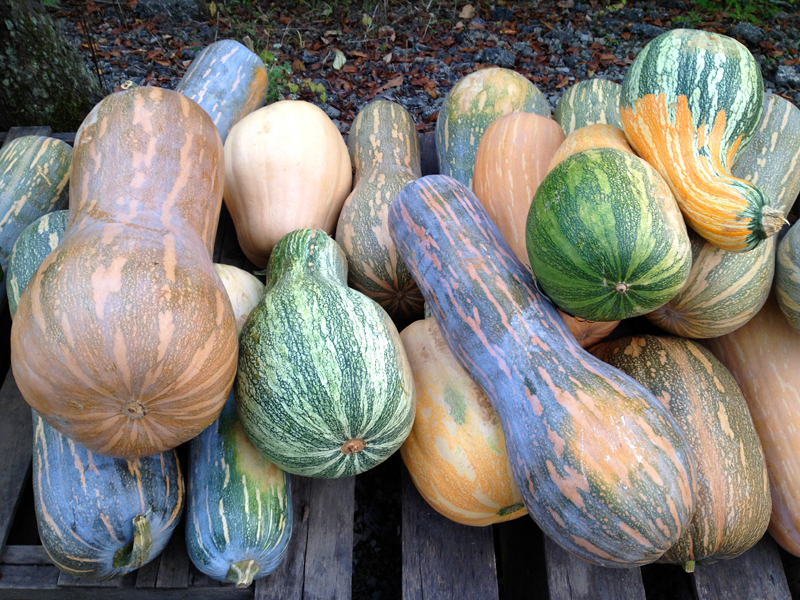
I couldn’t resist filling the back of my car with pumpkins for my parents to thank them for looking after the farm during my absence. Then back to rest, where the reading material provided in the hotel room was right up my alley:
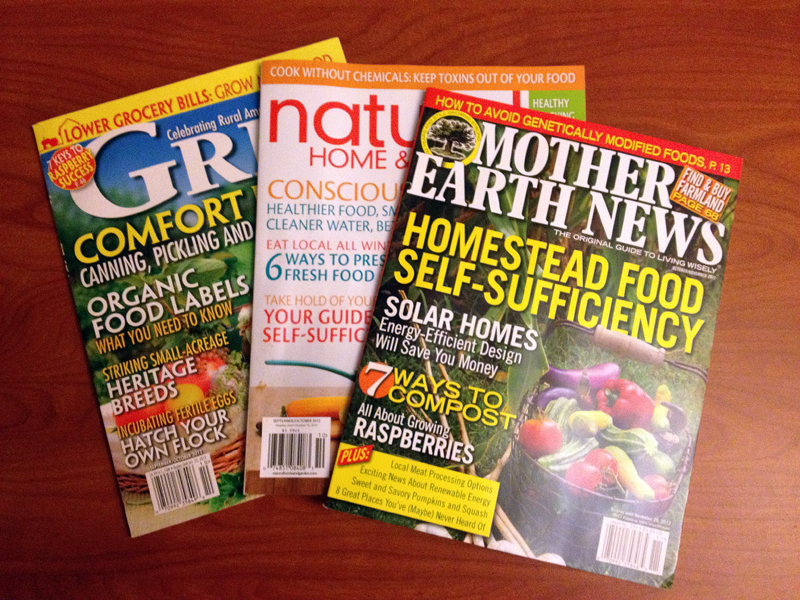
Stay tuned for day two of the fair, which got off to a squawk with a live chicken processing demo!
September 19th, 2012 §
For the Mother Earth News Fair this weekend in Seven Springs, PA. Leaving early Friday for a road trip that doesn’t include driving on any major interstates. How rare and wonderful will this journey be!

I am so excited to see some people speak who have figured out a way of living that massively appeals to me. Joel Salatin, Rosemary Gladstar, Patricia Foreman, Deborah Niemann, and many others whose blogs I follow and whose writings have taught me many life-changing things. I can’t wait to learn even more from them in person.
But I am most excited to support Jenna Woginrich, my personal hero, at her keynote speech. The blog she writes about her home, Cold Antler Farm, makes me cry and cheer in equal measure as she struggles, and succeeds, at living her most authentic life. Though I have never met her, she’s been one of my greatest sources of inspiration during the last few years. I hope I get to thank her in person in Seven Springs.
January 1st, 2012 §
In 2011 the pace of construction at Bonafide Farm slowed a bit—but of course when compared to building an entire house in 2010 that doesn’t mean much. But thanks to some pretty vigorous goal setting and the sweat of myself and others we accomplished a lot. All items in bold are linked to their original posts if you want to read more.
And so, in 2011, I:
Created a garden from scratch, and fed myself and others from it
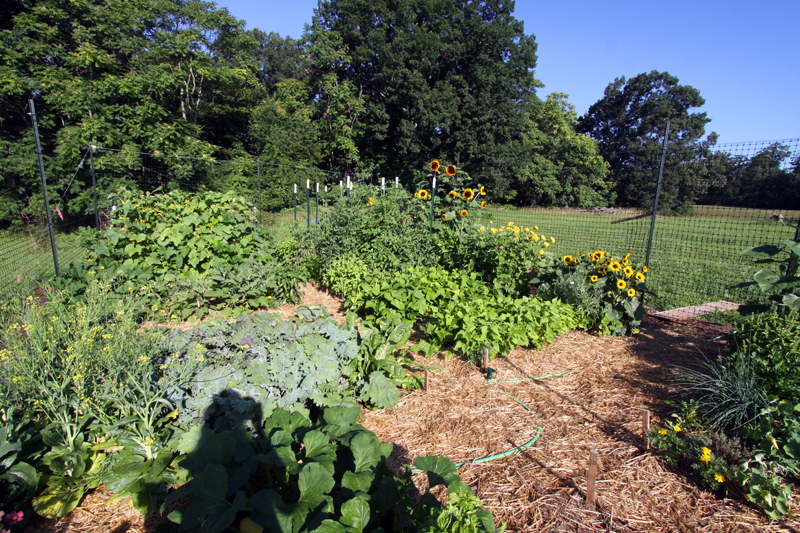
Carving a garden space out of a field was a major undertaking, and fencing and tilling and adding soil amendments and lining paths with landscape cloth took much of the fun out of the early garden season. But even with a late start I harvested my own food from May to late December, and for much of the summer ate only produce I grew. Plus, I gave bags of vegetables to coworkers, friends and family. Not bad for the first year out.
Completed the crawl space pit

Several summer weekends, including a historically hot Independence Day weekend, were devoted to mixing and pouring concrete to make the walls of my crawl space entry. This project was started in 2010, and I rest easier knowing my crawlspace is sealed off from, well, the creepy crawlies. The finished product is awesome and will be here long after I am dead and gone, but remind me next time to do concrete work when it’s not 100 degrees outside.
Designed and manufactured garden row covers to fight insects

Sweat + seed ticks is all I will say about this August project. But the infrastructure is in place for 2012’s covered rows.
Installed new forest
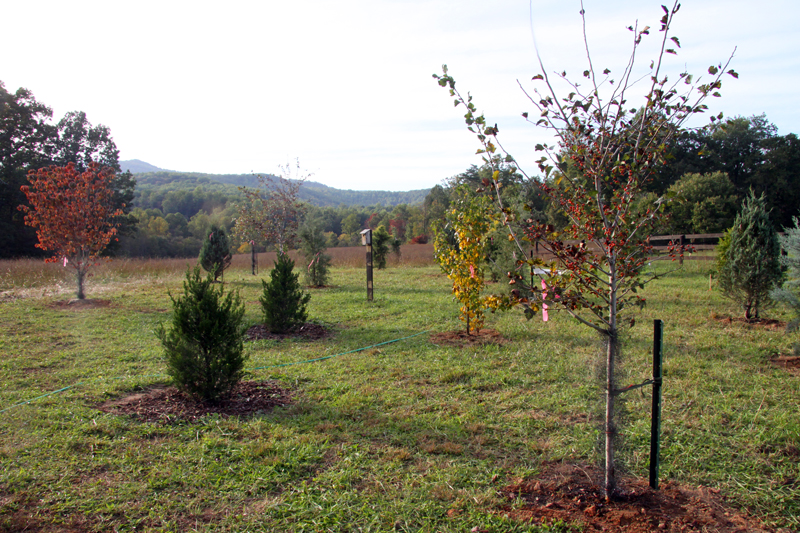
A couple of backbreaking weekends in September and I have a new mower slalom course in my back yard. Which, someday, I hope will be a living screen between my neighbors, the road, and my house.
Installed porch ceiling
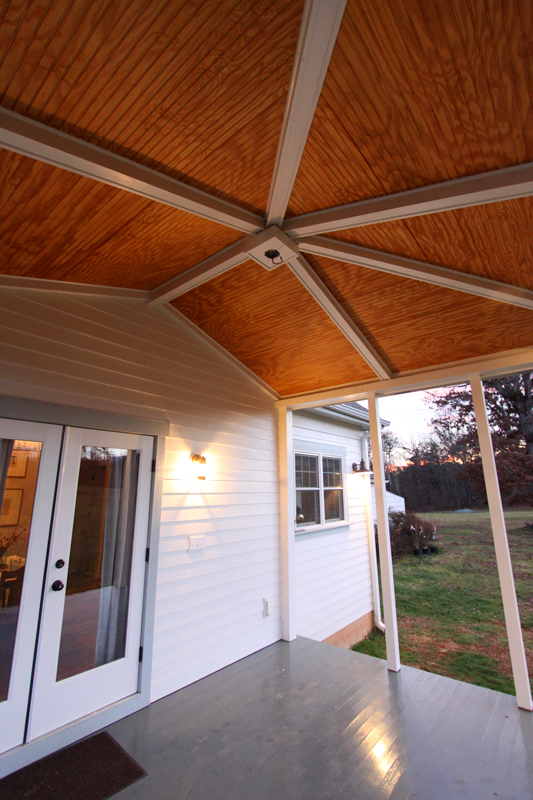
Dear starlings and mice: Consider yourselves evicted. Now to pick a cool fan for the box up there, install some rope lighting, and reinstall my outdoor speakers…
Trimmed coop
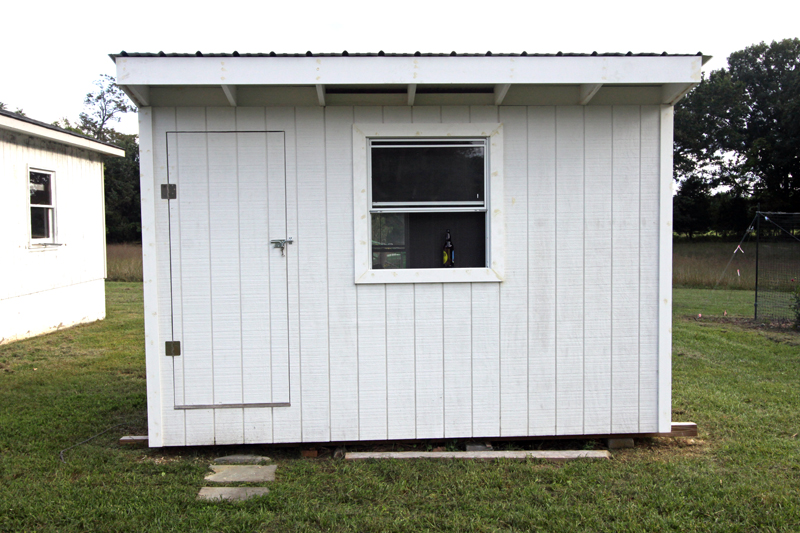
More than a year after the guineas first moved in, their little house is finally looking finished. I just need to hang a window box to pretty it up!
Repaired the garage and installed new doors and openers
This is the post I teased a while back but never got around to writing even though it was the single largest structural and cosmetic undertaking of the year. Much of October and November was spent supervising the repair of this:
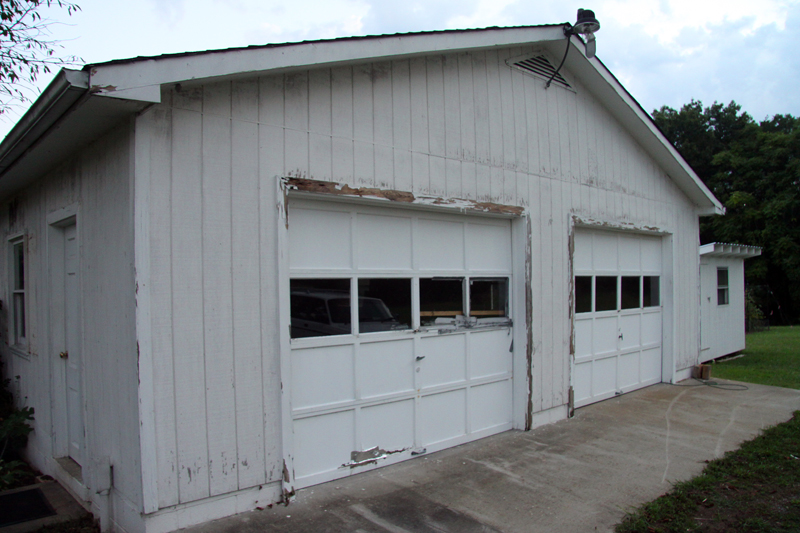
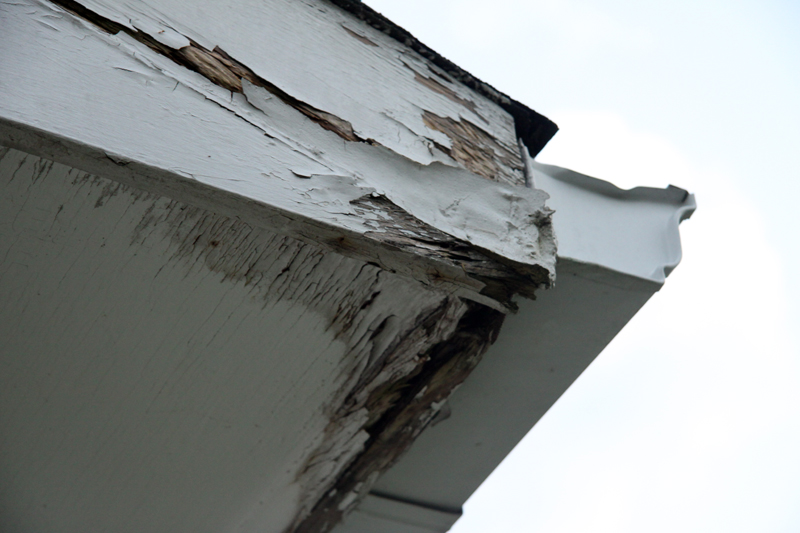
Now it looks like this: 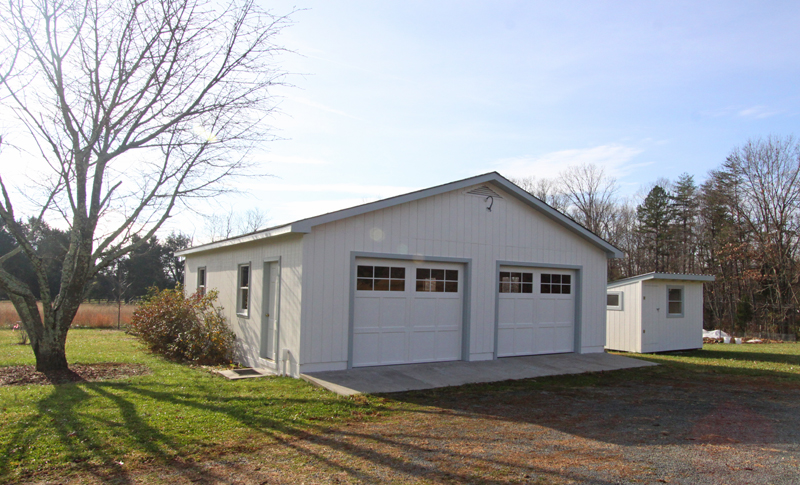
And when I come in the driveway after work, it’s such a luxury to push a button and have a garage door open—instead of parking and staring at a depressingly decrepit duct-taped mess.
Painting!
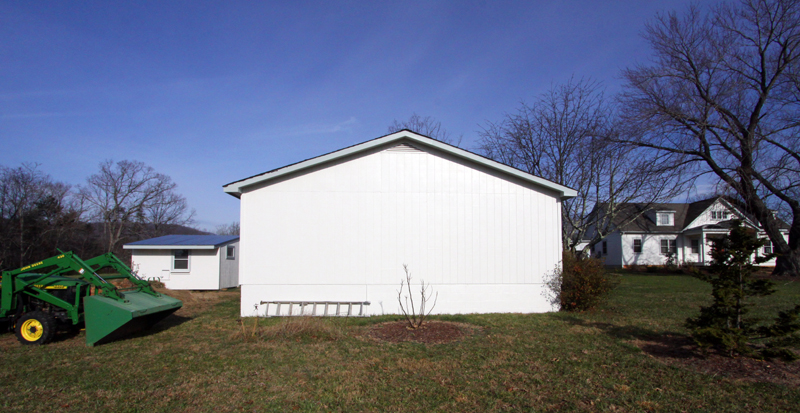
This fall, the completed porch ceiling, repaired garage and newly trimmed coop all got painted to match the house. I am trying to tie all my buildings together and the paint goes a long way toward that goal. As a bonus, I also had the front porch ceiling sealed and both porch floors repainted.
Personal goals
Though all of the above could fall under the personal goal of creating a farmish home, I also got to check off two major life list items.
I learned how to homebrew
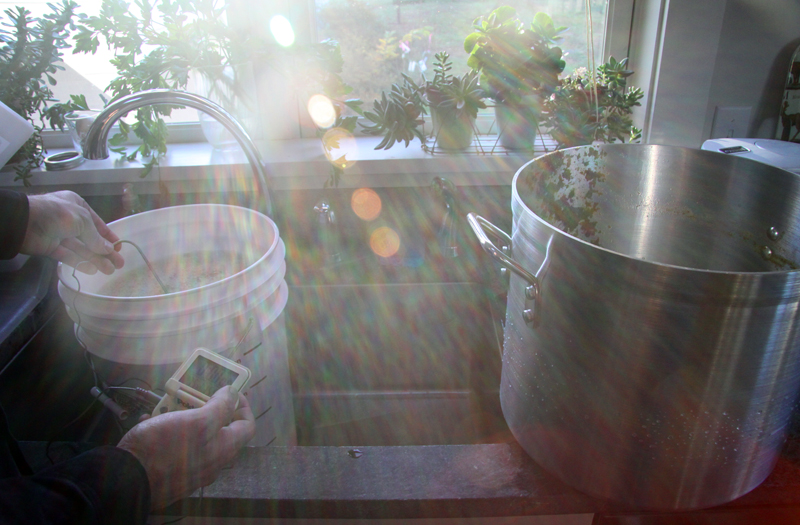
For this goal I am grateful to Brad, who set me down the path of true beer appreciation and shared his expertise over a very hoppy early November weekend. I raise a glass of my first IPA to you.
And, I raised a puppy
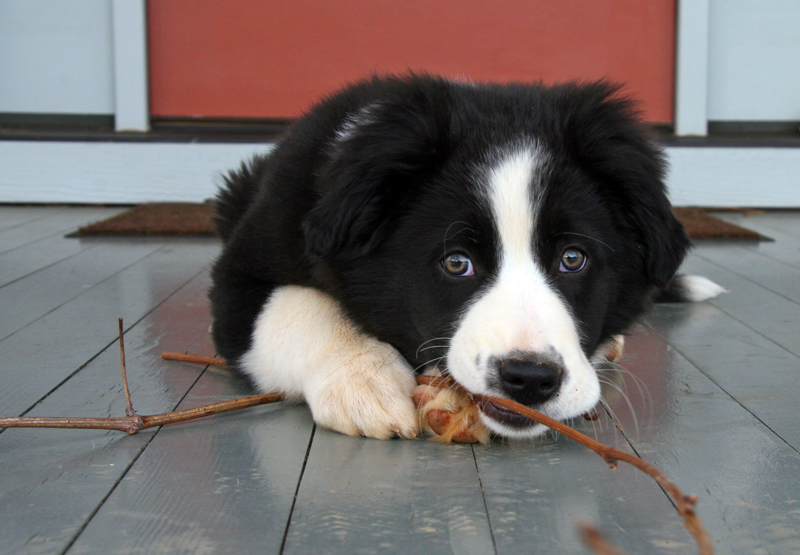 April 3, 2011
April 3, 2011
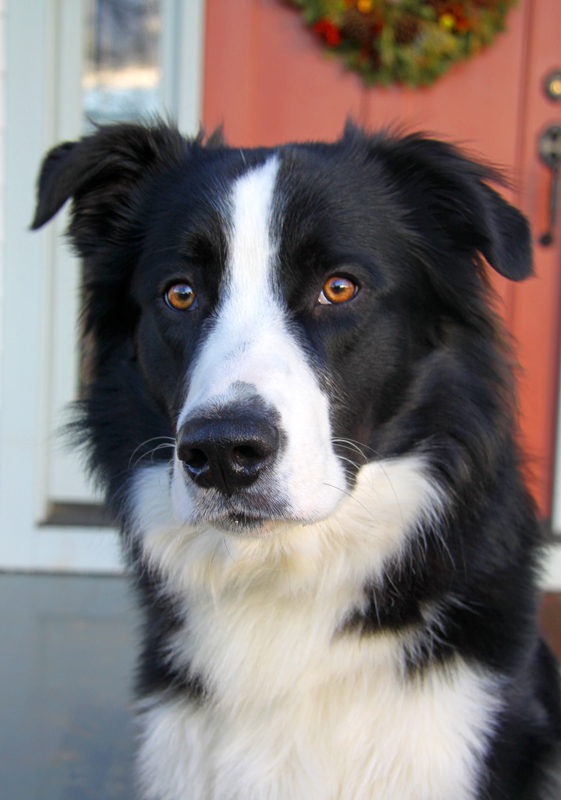 December 23, 2011
December 23, 2011
Wow, what an experience that was—and, as he nears his first birthday, continues to be! To say he turned my views of both dogs and relationships on their head doesn’t even touch it: all the things I worried about were nonissues and the parts I thought would be easy turned out to be the most challenging. I wouldn’t call much of it fun, but I am incredibly pleased with how Tuck is turning out, and grateful to him that he’s still willing to hang out with me—sleeping at my feet as I type this. I can’t wait to see how he matures.
So those were the highlights of 2011. I think it’s a fair amount accomplished, particularly in addition to living alone and working a full-time job. I am aware, however, of how none of it could have been done on my own. The two people who made most of it possible are my dad, who possesses the magical combination of neverending creativity, intelligence and energy, and who worked next to me through all these construction projects in addition to having his own full-time job and farm, and my mom, under whose loving attention Tucker has thrived and without whom I would never have been able to cross “raise a puppy” off my life list. Thank you both for being totally awesome.
And I would be remiss if I did not mention the cast of characters who move through this place, lending their skills and friendship to this dream. I am a very blessed girl. Thank you all, and we’ll reconvene soon to talk about plans for 2012.
June 7th, 2011 §
For strawberry cake!
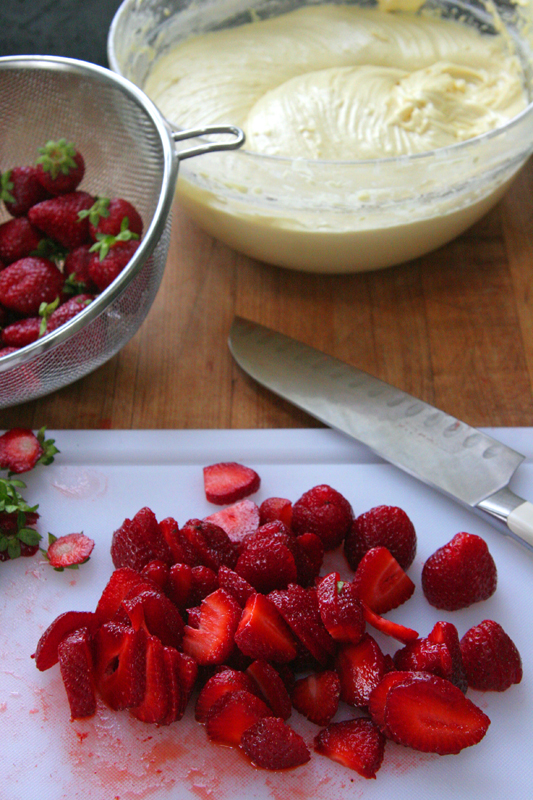
A friend gifted me with 10 lbs. of strawberries that he just picked out of the field at Seaman’s Orchard in Roseland, Va. All who enjoyed them agreed that they were the best berries in memory. Go pick some today before they’re gone!
